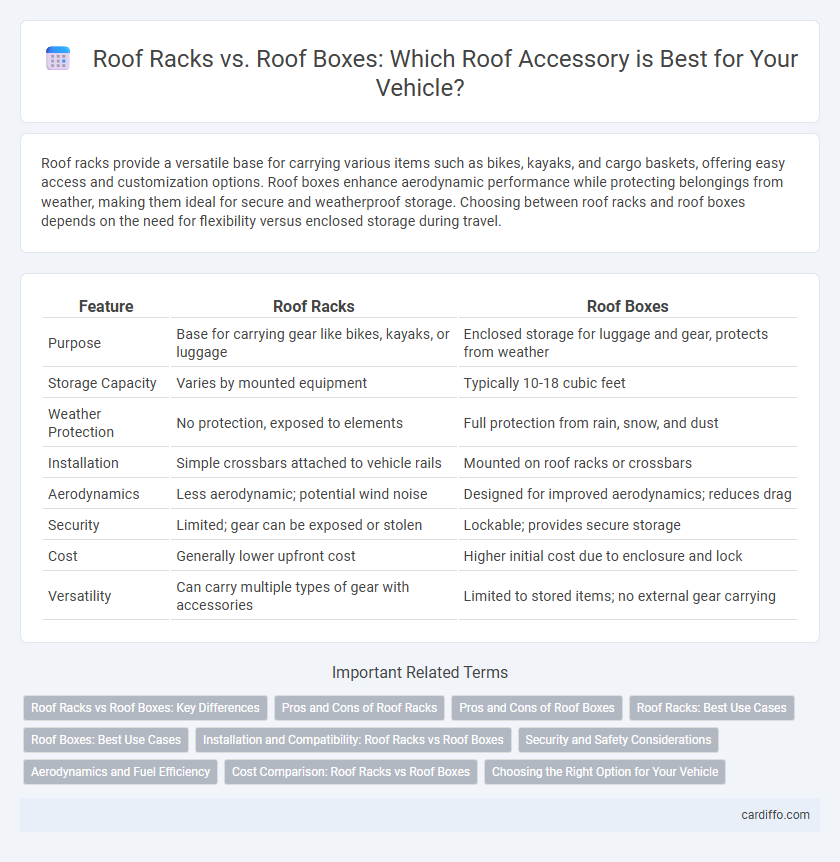Roof racks provide a versatile base for carrying various items such as bikes, kayaks, and cargo baskets, offering easy access and customization options. Roof boxes enhance aerodynamic performance while protecting belongings from weather, making them ideal for secure and weatherproof storage. Choosing between roof racks and roof boxes depends on the need for flexibility versus enclosed storage during travel.
Table of Comparison
| Feature | Roof Racks | Roof Boxes |
|---|---|---|
| Purpose | Base for carrying gear like bikes, kayaks, or luggage | Enclosed storage for luggage and gear, protects from weather |
| Storage Capacity | Varies by mounted equipment | Typically 10-18 cubic feet |
| Weather Protection | No protection, exposed to elements | Full protection from rain, snow, and dust |
| Installation | Simple crossbars attached to vehicle rails | Mounted on roof racks or crossbars |
| Aerodynamics | Less aerodynamic; potential wind noise | Designed for improved aerodynamics; reduces drag |
| Security | Limited; gear can be exposed or stolen | Lockable; provides secure storage |
| Cost | Generally lower upfront cost | Higher initial cost due to enclosure and lock |
| Versatility | Can carry multiple types of gear with accessories | Limited to stored items; no external gear carrying |
Roof Racks vs Roof Boxes: Key Differences
Roof racks provide an open framework mounted on a vehicle's roof, allowing flexible transport of oversized or awkwardly shaped items like bikes, kayaks, and ladders, while roof boxes are enclosed containers designed for secure, weatherproof storage, ideal for luggage and smaller gear. Roof racks offer versatility with customizable attachments, enabling easy loading and unloading, whereas roof boxes prioritize aerodynamic design and protection from elements, reducing wind noise and drag. Choosing between roof racks and roof boxes depends on the type of cargo, weather conditions, and need for security and aerodynamics during travel.
Pros and Cons of Roof Racks
Roof racks offer versatile cargo-carrying capabilities, allowing users to transport a variety of items such as bikes, kayaks, and large luggage that may not fit in standard roof boxes. They provide easier loading and unloading for irregularly shaped gear and can be more cost-effective due to their modular design and adaptability. However, roof racks often increase wind resistance and noise, potentially reducing fuel efficiency, and may require additional accessories or tie-downs to secure certain cargo properly.
Pros and Cons of Roof Boxes
Roof boxes offer secure, weatherproof storage with enhanced aerodynamics, making them ideal for long trips and protecting luggage from elements. Their bulkiness can increase wind resistance and reduce fuel efficiency, while installation and removal may require additional effort compared to roof racks. Roof boxes limit the ability to carry oversized items like bikes or kayaks, which are better suited for roof racks.
Roof Racks: Best Use Cases
Roof racks provide versatile and secure mounting solutions for transporting bulky gear such as bikes, kayaks, and ladders, maximizing roof space without fully enclosing items. They are ideal for users who require frequent loading and unloading or need to carry oversized equipment that doesn't fit inside a standard roof box. Roof racks also allow for customizable setups with various attachments, making them a preferred choice for outdoor adventure enthusiasts and tradespeople.
Roof Boxes: Best Use Cases
Roof boxes offer superior weather protection and enhanced security for storing luggage, sports equipment, and camping gear during long road trips or outdoor adventures. Their aerodynamic design reduces drag and noise, making them ideal for highway travel and extended journeys. Roof boxes are best suited for users requiring organized, spacious, and secure storage without compromising vehicle aesthetics or fuel efficiency.
Installation and Compatibility: Roof Racks vs Roof Boxes
Roof racks offer universal installation options with adjustable crossbars that fit most vehicle models, providing a versatile base for various accessories. Roof boxes require specific roof racks for mounting, making compatibility dependent on the type and size of the installed rack. Selecting the correct combination ensures secure attachment and optimal load distribution, enhancing both safety and performance.
Security and Safety Considerations
Roof racks provide versatile storage options but require proper installation and secure fastening to prevent items from shifting or falling during transit, which can pose safety risks. Roof boxes offer enhanced security with lockable designs that protect belongings from theft and weather damage while also improving aerodynamics to reduce wind noise and fuel consumption. Choosing between the two depends on balancing cargo protection, vehicle stability, and ease of loading to ensure optimal safety on the road.
Aerodynamics and Fuel Efficiency
Roof racks create more aerodynamic drag than roof boxes, leading to higher air resistance during driving. Roof boxes are designed with streamlined shapes that minimize turbulence and reduce the vehicle's drag coefficient. This aerodynamic efficiency translates into improved fuel economy compared to the increased fuel consumption caused by exposed roof racks.
Cost Comparison: Roof Racks vs Roof Boxes
Roof racks typically cost between $100 and $500, depending on the material and design, while roof boxes range from $200 to $1,000 or more based on size and aerodynamic features. Installation expenses vary, with roof racks sometimes requiring professional mounting that adds $50 to $150, whereas roof boxes usually mount directly onto racks without extra fees. Over time, roof boxes may incur additional costs for maintenance and storage, while roof racks offer a more permanent and versatile solution for multiple accessory attachments.
Choosing the Right Option for Your Vehicle
Roof racks offer versatile and customizable storage solutions suitable for a variety of vehicle types, ideal for transporting bulky items like bikes, kayaks, or ladders. Roof boxes provide weatherproof, secure, and aerodynamic storage, perfect for luggage and smaller gear, enhancing fuel efficiency and protecting contents from the elements. Matching the accessory to your vehicle's roof load capacity, usage needs, and available mounting options ensures optimal performance and safety.
Roof racks vs roof boxes Infographic

 cardiffo.com
cardiffo.com